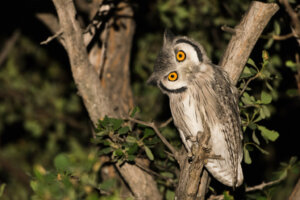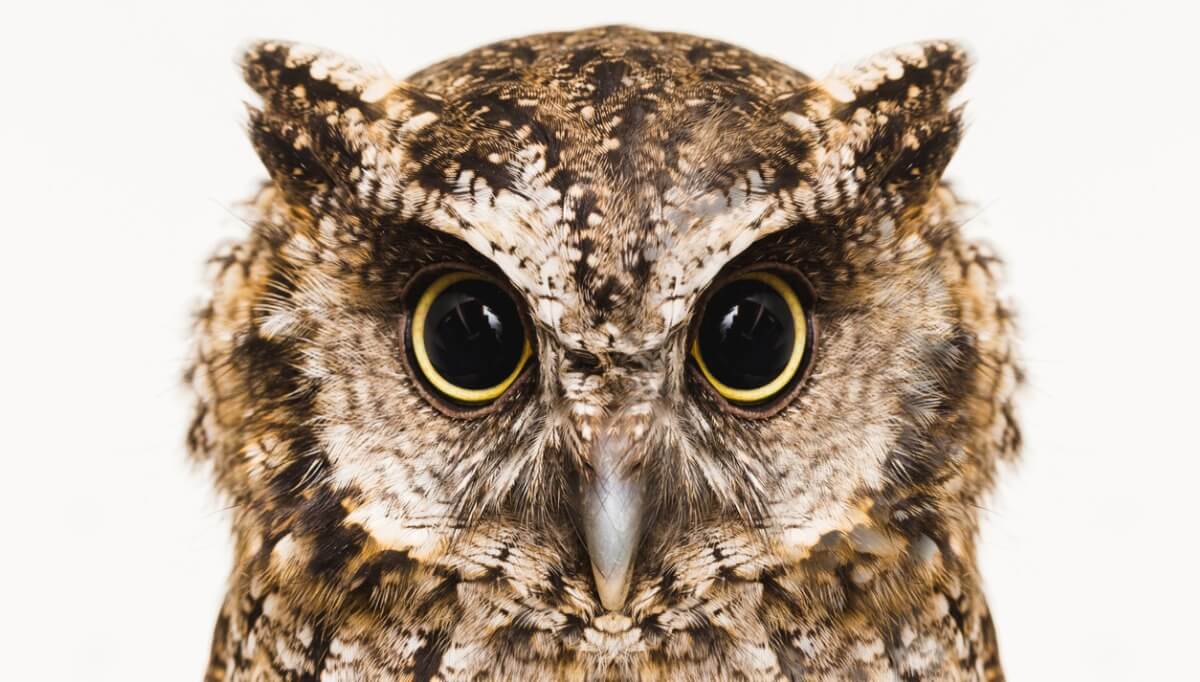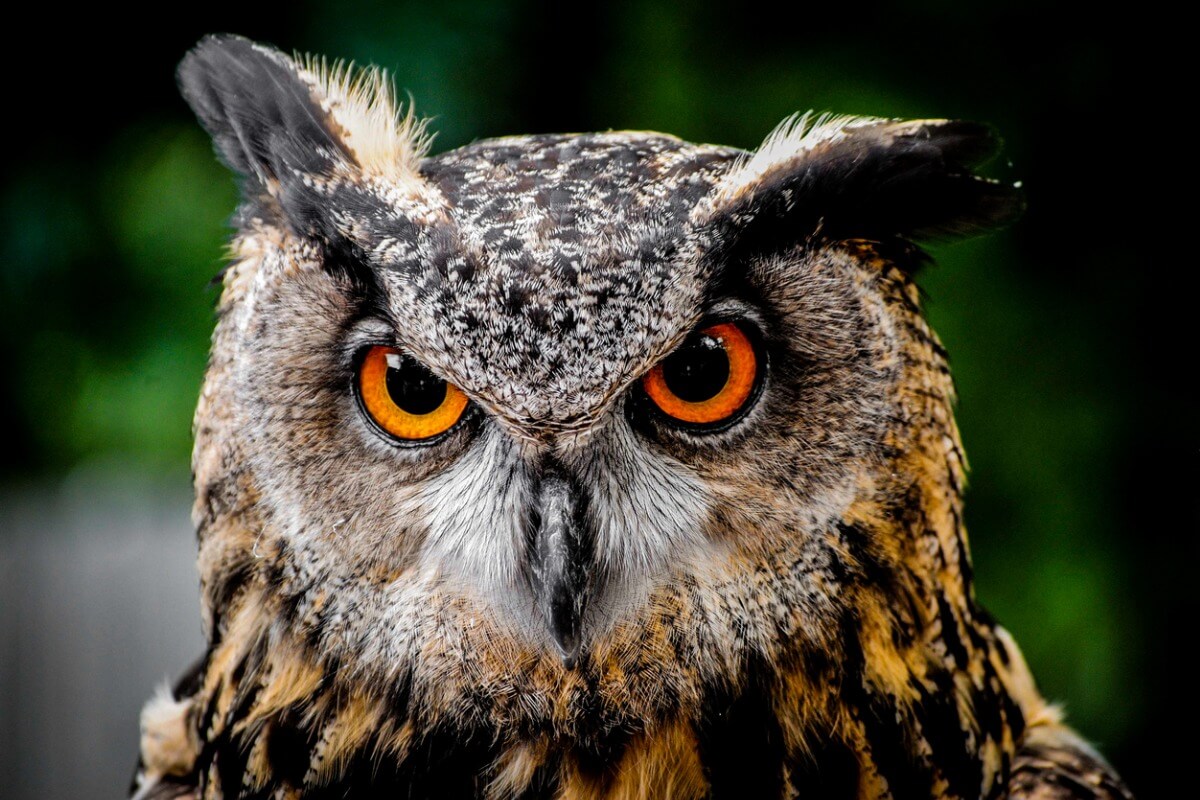How Do Owls Turn Their Heads?

It’s impossible to sneak up on them, as owls can turn their heads to limits unthinkable for humans. Clearly, they have something that other animals don’t have, otherwise they would surely die in the process.
But why do owls need this ability? How do they do it? Are they the only animals capable of carrying out this technique? The answer to these and other questions are in the following lines. Don’t miss it!
How can owls turn their heads to that point?
These nocturnal predators are endowed with an extraordinary sense of hearing and sight to find their prey in the dark. Owls, like other nocturnal animals, can’t see colors – at night it isn’t necessary – but their binocular vision is excellent.
On the other hand, an owl’s eyeballs – as with other raptors – are tubular in shape to improve their depth of vision, and it’s impossible for them to move them to scan their surroundings. This implies, directly, that they need to turn their neck to look at any point.

Can owls turn their heads 360 degrees?
Despite what you may think at first glance, these birds can’t actually turn their heads in a perfect circumference. However, they’re not far behind: owls are capable of turning their heads up to 270 degrees. To compare, humans can only manage 90 degrees.
It’s logical to think that it isn’t physically possible to rotate a neck so much, as it’s an area through which important tubes pass, such as the trachea, tendons and blood vessels. If this structure is twisted beyond its means, internal bleeding, interruption of the passage of air to the lungs and even cervical fractures would occur, but not the case of owls.
So how do owls do it?
Owls don’t damage their blood vessels or force their tendons on turning their necks, they’ve been specifically designed to carry out this action. Its entire cervical anatomy allows extreme twists without causing injury or interrupting the passage of air or blood to the brain.
The owl’s own cervical bone structure is designed for this extreme movement. While humans only have 7 cervical vertebrae, this raptor has 14. However, what’s really surprising is the design of its circulatory system, as studies indicate.
The cervical and cephalic arteries run the length of the spine, passing through small holes in each vertebra. In the case of these nocturnal birds of prey, these holes are 10 times wider than in humans. This excess space creates small air pockets, which prevent the strangulation of the vertebral artery. This allows the brain to continue to be irrigated during twisting.
On the other hand, these nocturnal birds have small interconnections between the carotid and vertebral arteries, which allows blood to exchange between them. In this way, if one pathway is blocked by twisting the neck, the other artery is still able to deliver blood to the brain.
The importance of this fact for human medicine
In conclusion, it never hurts to emphasize how much you can learn from animals. Any doctor who sees a nocturnal raptor turn its head that way will wonder how forests and habitats aren’t t full of owls lying dead on the ground.
Human arteries, which are fragile and thin, have nothing to do with the thick arteries owls have, and their interconnections. Human tendons and muscles are much less flexible than those of these wonderful birds. All strigiform birds — owls, owlets, barn owls, and so on — possess these robust motor and circulatory systems.

What can be quite creepy in the legends and stories surrounding these creatures, can actually be a source of information that could save lives in human medicine. What else do these incredible creatures have to tell us? Science will surely give us more answers over time!
It’s impossible to sneak up on them, as owls can turn their heads to limits unthinkable for humans. Clearly, they have something that other animals don’t have, otherwise they would surely die in the process.
But why do owls need this ability? How do they do it? Are they the only animals capable of carrying out this technique? The answer to these and other questions are in the following lines. Don’t miss it!
How can owls turn their heads to that point?
These nocturnal predators are endowed with an extraordinary sense of hearing and sight to find their prey in the dark. Owls, like other nocturnal animals, can’t see colors – at night it isn’t necessary – but their binocular vision is excellent.
On the other hand, an owl’s eyeballs – as with other raptors – are tubular in shape to improve their depth of vision, and it’s impossible for them to move them to scan their surroundings. This implies, directly, that they need to turn their neck to look at any point.

Can owls turn their heads 360 degrees?
Despite what you may think at first glance, these birds can’t actually turn their heads in a perfect circumference. However, they’re not far behind: owls are capable of turning their heads up to 270 degrees. To compare, humans can only manage 90 degrees.
It’s logical to think that it isn’t physically possible to rotate a neck so much, as it’s an area through which important tubes pass, such as the trachea, tendons and blood vessels. If this structure is twisted beyond its means, internal bleeding, interruption of the passage of air to the lungs and even cervical fractures would occur, but not the case of owls.
So how do owls do it?
Owls don’t damage their blood vessels or force their tendons on turning their necks, they’ve been specifically designed to carry out this action. Its entire cervical anatomy allows extreme twists without causing injury or interrupting the passage of air or blood to the brain.
The owl’s own cervical bone structure is designed for this extreme movement. While humans only have 7 cervical vertebrae, this raptor has 14. However, what’s really surprising is the design of its circulatory system, as studies indicate.
The cervical and cephalic arteries run the length of the spine, passing through small holes in each vertebra. In the case of these nocturnal birds of prey, these holes are 10 times wider than in humans. This excess space creates small air pockets, which prevent the strangulation of the vertebral artery. This allows the brain to continue to be irrigated during twisting.
On the other hand, these nocturnal birds have small interconnections between the carotid and vertebral arteries, which allows blood to exchange between them. In this way, if one pathway is blocked by twisting the neck, the other artery is still able to deliver blood to the brain.
The importance of this fact for human medicine
In conclusion, it never hurts to emphasize how much you can learn from animals. Any doctor who sees a nocturnal raptor turn its head that way will wonder how forests and habitats aren’t t full of owls lying dead on the ground.
Human arteries, which are fragile and thin, have nothing to do with the thick arteries owls have, and their interconnections. Human tendons and muscles are much less flexible than those of these wonderful birds. All strigiform birds — owls, owlets, barn owls, and so on — possess these robust motor and circulatory systems.

What can be quite creepy in the legends and stories surrounding these creatures, can actually be a source of information that could save lives in human medicine. What else do these incredible creatures have to tell us? Science will surely give us more answers over time!
All cited sources were thoroughly reviewed by our team to ensure their quality, reliability, currency, and validity. The bibliography of this article was considered reliable and of academic or scientific accuracy.
- Posters & Graphics. (2013, 1 febrero). Science. https://science.sciencemag.org/content/339/6119/514
- Strigiformes – es.LinkFang.org. (2021). LinkFang. https://es.linkfang.org/wiki/Strigiformes
- Boumans, M. L., Krings, M., & Wagner, H. (2015). Muscular arrangement and muscle attachment sites in the cervical region of the american barn owl (Tyto furcata pratincola). PLoS One, 10(7), e0134272.
- Bent, A. C. (1961). Life histories of North American birds of prey: orders Falconiformes and Strigiformes (Vol. 167). US Government Printing Office.
This text is provided for informational purposes only and does not replace consultation with a professional. If in doubt, consult your specialist.








